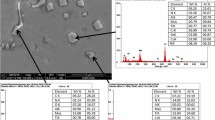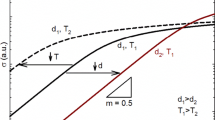Abstract
The creep behavior of mullite was studied under different stresses and in the temperature range 1200–1450 °C, and an analysis of creep curves was proposed. The study of creep behavior of mullite at high temperatures clearly indicates that this material exhibits concurrent creep and slow crack growth. An effective transition stress exists at each temperature. The analysis takes account of the total creep curve; in particular, the primary and stationary stages. It is now possible to determine by extrapolation the steady-state creep rate for specimens that break in the transient domain during tests. Thus, one can verify the influence of the stress on the steady-state creep rate over a wide stress range. On the other hand, this analysis clearly indicates the existence of two values of the activation energy around 1300 °C; this suggests a change of creep mechanism at this temperature.
Similar content being viewed by others
References
H. Ohnishi, T. Kawanami, K. Miyazaki, and T. Hiraiwa, Mechanical Properties of Mullite (Lûbeck, Germany, 1986), pp. 633–641.
M. Mizuno, J. Am. Ceram. Soc. 74(12), 3017 (1991).
R. Torrecillas, Ph.D. Thesis, INSA, Lyon, France (1994) (in French).
H. Rhanim, Ph.D. Thesis, UCD, EL Jadida, Morocco (1996) (in French).
G.W. Hollenberg, G.R. Terwilliger, and R.S. Gordon, J. Am. Ceram. Soc. 54(4), 196 (1991).
G. Terence, Ceramurgia Int. 6(1), 11 (1980).
J. Cadek, Creep in Metallic Materials (Elsevier, Amsterdam, The Netherlands, 1988).
R. Raj and M.F. Ashby, Metall. Trans. 2(4), 1113 (1971).
A.G. Evans and A. Rana. Acta Metall. 28, 129 (1980).
R.W. Evans, J.D. Parker, and B. Wilshire, in Recent Advances in Creep and Fracture of Engineering Materials and Structure, edited by B. Wilshire and D.R.J. Owen (Pineridge Press, Swansea, U.K. 1982), p. 135.
R.W. Evans and B. Wilshire, in Creep of Metals and Alloys (The Institute of Metals, London, U.K., 1985), p. 197.
J.L. Ding, K.C. Liu, K.L. More, and C.R. Brinkman, J. Am. Ceram. Soc. 77(4), 867 (1994).
H. Rhanim, C. Olagnon, G. Fantozzi, and R. Torrecillas, Ceram. Int. 23(6), 497 (1997).
F. Dobes and J. Cadek, Met. Mater. 19, 31 (1981).
Author information
Authors and Affiliations
Rights and permissions
About this article
Cite this article
Rhanim, H., Olagnon, C., Fantozzi, G. et al. High-temperature deformation of mullite and analysis of creep curves. Journal of Materials Research 18, 1771–1776 (2003). https://doi.org/10.1557/JMR.2003.0246
Received:
Accepted:
Published:
Issue Date:
DOI: https://doi.org/10.1557/JMR.2003.0246




